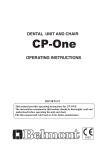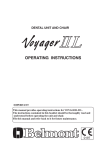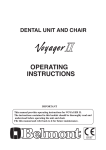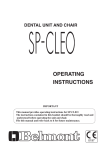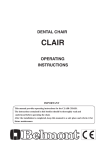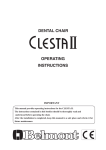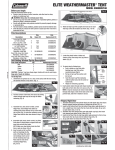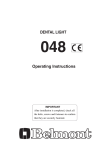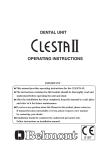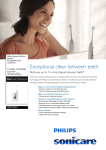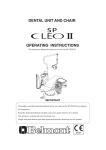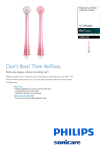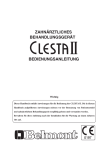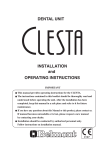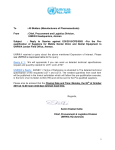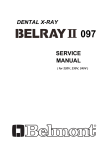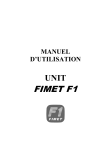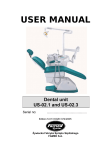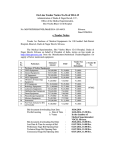Download OPERATING INSTRUCTIONS
Transcript
DENTAL UNIT AND CHAIR OPERATING INSTRUCTIONS IMPORTANT This manual provides operating instruction for BELMONT RAPPORT. The instructions contained in this booklet should be thoroughly read and understood before operating of the system. File this manual and refer back to it for future maintenance. R 0197 TABLE OF CONTENTS Page 1. OVERALL VIEW AND MAJOR PARTS----------------------------------------------------------- 1 1-1. TABLE UNIT AND DOCTOR UNIT SECTION------------------------------------------------ 1 1-2. ASSISTANT UNIT AND DENTAL LIGHT SECTION---------------------------------------- 2 1-3. CHAIR SECTION----------------------------------------------------------------------------------- 3 2. DIMENSIONS 2-1. CHAIR DIMENSIONS------------------------------------------------------------------------------ 4 2-2. TABLE UNIT DIMENSIONS---------------------------------------------------------------------- 4 2-4. POLE MOUNT LIGHT DIMENSIONS --------------------------------------------------------- 5 2-3. ASSISTANT UNIT DIMENSIONS--------------------------------------------------------------- 5 3. LAYOUT AND SPECIFICATIONS 3-1. LAYOUT---------------------------------------------------------------------------------------------- 6 3-2. SPECIFICATIONS----------------------------------------------------------------------------------- 6 4. OPERATION INSTRUCTIONS 4-1. MASTER SWITCH AND CHAIR MAIN SWITCH-------------------------------------------- 7 4-2. CONTROL PANELS-------------------------------------------------------------------------------- 7 4-3. CHAIR POSITIONS AND CHAIR OPERATING INSTRUCTIONS------------------------ 8 4-4. UNIT OPERATING INSTRUCTIONS---------------------------------------------------------- 11 4-5. SUPPORT FUNCTIONS--------------------------------------------------------------------------- 14 4-6. CEILING LIGHT OPERATING INSTRUCTIONS-------------------------------------------- 17 5. ADJUSTMENTS 5-1. CHAIR AUTO MODE POSITION ADJUSTMENTS----------------------------------------- 18 5-2. HANDPIECE HOLDER FUNCTION CANCELLATION AND RESET------------------- 18 6. CARE AND MAINTENANCE 6-1. CARE AND MAINTENANCE FOR CHAIR--------------------------------------------------- 19 6-2. CARE AND MAINTENANCE FOR UNIT----------------------------------------------------- 19 6-3. CARE AND MAINTENANCE FOR POLE MOUNT LIGHT ------------------------------ 21 7. ELECTROMAGNETIC COMPATIBILITY(EMC) -------------------------------------------- 22 8. LIST OF COMPATIBLE HANDPIECES --------------------------------------------------------- 25 Intended Use of the Product This product is an active therapeutic device intended for the exclusive use for diagnoses, treatments and relative procedures of dentistry. The product must be operated or handled by the qualified dentists or by dental staffs under the supervision of the dentist. Such dentists or dental staffs should instruct and/or assist the patients to approach to and leave from the product. Patients should not be allowed to operate or handle the product unless he/she is so instructed. The product is supplied together with the handpieces like electric micromotor, air turbine and/or motor, scaler and so on. Environmental Requirements Ambient Temperature Operating +5℃ - +40℃ Humidity 10 % - 80% Storage -10℃ - +50℃ Atmospherical Pressure 600 hPa - 1060 hPa Compatibility of Handpieces Use the compatible handpieces as shown on the attached list for this unit. (List of compatible handpieces). Important Notes In case of the troubles, please contat Takara Belmont offices or your dealers. Do not disassemble or attempt to repair. Disassembly, repair or modifications shoud only be done by a qualified repair technician. Attempts at disassembly, repair or modifications may lead to abnormal operation and accidents. In case of disposal of equipment In case of disposal of equipment or of components dismounted from the unit, take full infection preventing measures, and carry out appropriate steps in accordance with the legal regulations at that time. SYMBOLS )2 㹌 Chair preset1 Chair auto control Chair auto control To raise the chair To lower the chair To Recline the backrest To raise the backrest Treatment position Consultation position Toothbrushing position Handpiece Setting Fiber optic handpiece light on//off Micro motor otation mode select Micro motor Forward/Reverse select Handpiece water flow control Handpiece memory Fiber optic handpiece light on//off Handpiece coolant water on/off Handpiece coolant air on/off Micro motor speed control Dental light on/off Flush out Syringe Function Store Bowl flush Cupfiller Dental light ON/OFF Stand by Timer Alarm Chair lock indicator Water heater Air Non-ionizing radiation Type B Applied Parts Date of manufacture Caution It means “caution, warnings, or possibility to danger”. Separate collection for electrical and electronic equipment Chair last position Chair auto return Chair manual control Water Manufacturer 㻨㻦 㻵㻨㻳 Authorized representative in the European community 㸶 㹅㸦 1. OVERALL VIEW AND MAJOR COMPONENTS 1-1. TABLE UNIT AND DOCTOR UNIT SECTION 1 13 14 17 2 4 3 15 18 16 19 27 20 21 12 11 22 5 10 23 9 26 8 24 6 7 25 Table Unit Section Doctor Unit Section Fig.1-1 Table Unit and Doctor Unit Section Overall View TABLE UNIT AND DOCTOR UNIT SECTION MAJOR COMPONENTS 17. Doctor Unit Control Panel 1. Partition Panel 18. Handle 2. Panorama Viewer 19. Doctor Unit Front Cover 3. Master Switch 20. Handpiece Tubing 4. Table unit Top 21. Doctor’s Syringe 5. Doctor Unit 22. Oil Mist Separator 6. Printer Case 23. Doctor Unit Frame 7. Side Cover 24. Table Arm 8. Cuspidor Cover 25. Table Flange 9. Cuspidor Bowl 26. Waste Receptacle 10. Cupfiller Sensor 27. Handpieces 11. Bowl Flush Nozzle 12. Cupfiller Nozzle (Micromotor, Air Turbine/Motor, 13. Doctor Unit Table Top Scaler and etc.) Manufacturers recommend 14. Table Housing to use the handpieces with CE markings 15. Handpiece Pressure Gauge 16. Doctor Unit Handpiece Holder -1- 1-2. ASSISTANT UNIT AND DENTAL LIGHT SECTION 10 8 7 1 9 13 12 2 3 11 4 6 14 15 5 16 17 Assistant Unit Section Pole Mount Light (IO 5000) Fig.1-2 Assistant Unit and Dental Light Section Overall View ASSISTANT UNIT AND DENTAL LIGHT SECTION MAJOR PARTS 1. Assistant Unit Table Top 2. Cuspidor Unit Control Panel 3. Solid Collector 4. Side Panel 5. Foot Controller (SP Type) 6. Assistant Side Instrument Holder 7. Vacuum Handpiece 8. Saliva Ejector 9. Assistant’s Syringe 10. Assistant Unit Control Panel -2- 11. Light Head 12. Balance Arm 13. Light Pole 14. Light Post 15. Light Bracket 16. Light Base Cover 17. Light Base 1-3. CHAIR SECTION 1 12 2 3 3 13 14 15 4 11 5 16 6 10 10 7 8 8 17 18 9 Fig.1-3 Chair Section Overall View CHAIR SECTION MAJOR PARTS 1. Headrest 2. Backrest 3. Armrest 4. Side Frame 5. Side Cover 6. Bellows 7. Pump Cover 8. Chair Main Switch 9. Base Plate 10. Legrest 11. Seat 12. Headrest Angle Lock Lever 13. Headrest Cover 14. Chair Rotation Lock Release Button 15. Backrest Cover 16. P.C.B. Cover 17. Chair Manual Control Stick Switch 18. Ceiling Light Control Stick Switch -3- 2. DIMENSIONS 2-1. CHAIR DIMENSIONS 9 0° 155° 500 600 65 ° ° 75 -mm- 1360 650 ° 55° 475∼735 -4° 20° 1155∼1415 78 540 Fig.2-1 Chair Dimensions 2-2. TABLE UNIT DIMENSIONS -mm0 340 1100 95 ° 750 500 28 410 1480 1720 1420 720 Fig.2-2 Table Unit Dimensions -4- 785 745 1300 735 2-3. ASSISTANT UNIT DIMENSIONS -mm490∼630 630 1050∼1195 310 145 50° ° 960 880 75 Fig.2-3 Assistant Unit Dimensions 2-4. POLE MOUNT LIGHT (IO 5000) DIMENSIONS (OPTIONAL) 650 -mm- 1900 1045 Fig.2-4 Pole Mount Light (IO 5000) Dimensions -5- 3. LAYOUT AND SPECIFICATIONS 3-1. LAYOUT Completed Rapport setting position layout is shown in Fig.3-1. 2500 1125 1335 0 32° 2150 1000 28 30 0 525 625 1000 Fig.3-1 Setting Position Latout 3-2. SPECIFICATIONS Seat Initial Height........................................ 475mm Chair Section Seat lifting Stroke......................................... 260mm Backrest Angle............................................. 0 ~ 82˚ Chair Rotation.............................................. 138˚ (Right 90˚, Left 48˚) Control Voltage............................................ DC12V Power Consumption..................................... AC230V, 50Hz, 510W Maximum Load............................................ 135 kg Net Weight.................................................... 122kg Unit Section Power Requirement...................................... AC230V, 50Hz 3.4A Compressed Air Pressure Requirement........ 0.54 - 0.59 Mpa(5.5 - 6.0 kg/m2) Compressed Air Supply Capacity................ 60 l/min Water Pressure Requirement........................ 0.14 - 0.19 Mpa(1.5 - 2.0 kg/m2) Saliva Ejector............................................... Central Type Vacuum......................................................... Central Type Table Unit Net Weight.................................. 95kg Doctor Unit Net Weight............................... 25kg Assistant Unit Net Weight............................ 20kg Pole Mount Light 5000) Section (IO Power Requirement...................................... AC230V, 50Hz Light Intensity.............................................. 28000/22000/15000Lx Colour Temperature...................................... 5000K Net Weight.................................................... 12kg Service Life.................................................. 10 Years -6- 4. OPERATING INSTRUCTIONS 4-1. MASTER SWITCH AND CHAIR MAIN SWITCH Note : Before operation, confirm that air compressor is fully charged. The chair can be operated only when both the master switch and the chair main switch are ON. (1) Master Switch (Fig.4-1) Turn on the master switch located on side of the film viewer, master switch illuminates in Master Switch green. CAUTION Turn off the master switch after daily operation. I ON O OFF (2) Chair Main Switch (Fig.4-2) Fig.4-1 Master Switch CAUTION Operate the chair main switch only by hand. I (ON) Turn on the chair main switch located on the left side of the pump cover, chair main switch illuminates in green. Main Switch O (OFF) Fig.4-1 Chair Main Switch 4-2. CONTROL PANELS (Fig.4-3 & Fig.4-4) Control panels and switch locations and functions are shown in Fig.4-3 and Fig.4-4. Doctor Unit Control Panel Chair Rotation Lock Release Button Assistant Unit Control Panel Cuspidor Unit Control Panel Chair Manual Control Stick Switch Chair Auto Mode Stick Switch Fig.4-3 Control Panels and Switch Positions -7- Function Indicator Unit Control Switches F.O 1 Bowl Flush Switch 2 0 3 P1 4 Chair Auto Mode Switches 0 P1 F.O LP Chair Auto Mode Switches Assistant Unit Control Panel LP Doctor Unit Control Panel Fig.4-4 Control Panel Functions 4-3. CHAIR POSITIONS AND CHAIR OPERATING INSTRUCTIONS CAUTION Before operating the chair, confirm safety for the patient and the operator. 0 P1 F.O Chair auto mode movements are controlled by chair auto mode switches. (Fig.4-5) (1) Initial Position (Fig.4-6) This position is for patient’s entry to and descent from the chair. Chair rotation angle is 0˚ with lowest seat position and Fig.4-5 Chair Auto Mode Switches upright backrest position. Momentarily depress the auto return switch ( 0 ) on the control panel, chair will return to the initial position Table Unit automatically from any position. LP 0 0 Chair Fig.4-6 Initial Position and Auto Return Switch Table Unit 90 Chair Note : Each chair rotation angle described here is lotated clockwise from initial position (0˚). (2) Consultation Position (Fig.4-7) This position is for consultation. Chair rotation is 90˚with lowest seat position and upright backrest position. Momentarily depress the consultation position switch ( ) on the control panel, chair will rotate to the consultation position automatically. Note : Any chair manual control switch can not be operated Fig.4-7 Consultation Position and at this position for safety. Consultation Position Switch -8- 18 0 Fig.4-8 6 O’clock Position and 6 O’clock Position Switch (3) 6 o'clock Position (Fig.4-8) This position is for 6 o'clock treatment or examination (face to face treatment position). Chair rotation is 180˚with lowest seat position and upright backrest position. Momentarily depress the 6 o’clock position switch ( ) on the control panel, chair will move to the 6 o'clock treatment position automatically. Chair seat height can be adjusted at this position, by depressing ( ) or ( ) switch on the control panel. (4) Toothbrushing Position (Fig.4-9) This position is for toothbrushing training. Chair rotation is 90˚ with lowest seat position and up right backrest position. Cuspidor bowl comes out from the table unit automatically. Momentarily depress the toothbrushing position switch ( ) on the control panel, chair will move to the Table Unit 90 Chair toothbrushing position and cuspidor bowl will come out Fig.4-9 Toothbrushing Position and to the left side of chair from the table unit automatically. Toothbrushing Position Switch Note : Any chair manual control switch can not be operated at this position for safety. Table Uint 0 Chair P1 (5) Treatment Position (Preset Position) (Fig.4-10) This position is for treatment. Chair rotation angle is 0˚ with memorized seat height and memorized backrest angle. Treatment position seat height and backrest angle can be memorized independently. Momentarily depress the Preset Switch ( ) on control panel, the chair will move to the treatment position automatically. Seat height and backrest angle can be adjusted by the stick switch at this position. P1 Fig.4-10 Treatment Position and Preset Switch (6) Chair Rotation Manual Adjustment (Fig.4-11) Chair Rotation Lock Button CAUTION Do not press the rotation lock button during automatic procedure. Chair rotation can be adjusted by manual control. Keep pressing the chair rotation lock button,to rotate the chair. Adjust chair rotation angle to the desired position and release the rotation lock button. Fig.4-11 Rotation Lock Button In case rotated over the rotation limit, an alarm buzzer sounds. Rotate the chair between rotation limits. -9- (7) Last Position Memory (Fig.4-12) Momentarily depress the last position memory switch ( LP ) Table Unit on the control panel at the treatment position, the backrest 0 will raise to upright position and the seat lowered to mouth rinsing and the cuspidor bowl will come out to the right side Chair of chair from the table unit automatically. Momentarily depress the last position memory switch ( LP ) again, the backrest and seat will return to the previous Fig.4-12 Last Memory Position and treatment position and the cuspidor bowl will be retracted Last Position Memory into the table unit. Switch LP Note : Last position memory is effective only at the treatment position. (8) Emergency Stop During automatic procedure, depressing any button or stick switch will cancel the automatic movement immediately. Note : After emergency stop, confirm the safety and return the chair to the initial position by depressing the auto return switch ( 0 ) button, then reset the chair position. (9) Manual Control by Stick Switch (Fig.4-13) Manual mode chair control stick switch is located on the right side of pump cover rear. A. Seat Lifting--------------Keep pressing the stick switch to upward until the seat is lifted up to the desired position. B. Seat Lowering-----------Keep pressing the stick switch to downward until the seat is lowered to the desired position. C. Backrest Reclining------Keep pressing the stick switch to left side until the backrest is reclined to the desired position. D. Backrest Raising--------Keep pressing the stick switch to right side until the backrest is raised up to the desired position. (10) Headrest Operation (Fig.4-14) A. Height Adjustment----- Press or pull up the headrest to the desired height. B. Angle Adjustment ----- Push the headrest angle lock lever to rotate backward and release the headrest angle lock lever at the desired position. Seat Lifting Backrest Reclining Chair Auto Mode Control Stick Switch Angle Adjustment Chair Manual Control Stick Switch Backrest Raising Seat Lowering Fig.4-13 Manual Control Stick Switch Headrest Angle Lock Lever Height Adjustment Fig.4-14 Headrest Operations -10- 4-4. UNIT OPERATING INSTRUCTIONS Paper Cup (1) Sensor Cupfiller (Fig.4-15 & Fig.4-16) Cupfiller Nozzle Place a cup (paper cup) on the cuffiller base, water comes Sensor Cupfiller out from the cupfiller nozzle to fill the cup, and stops Bowl Flush Nozzle automatically. During filling the cup , momentarily pressing the cupfiller switch ( ) will stop filling. Note : Use suitable disposable paper cup only. Empty the cup before placing it on the base to prevent water from overflowing. Fig.4-15 Sensor Cupfiller Fig.4-16 Cupfiller Switch (2) Cupfiller Switch (Fig.4-16) Momentarily press the cupfiller switch ( ), cupfiller water comes out from the cupfiller nozzle for about 4 seconds and stops automatically. During the cupfilling, pressing the cupfiller switch ( ) stops filling. The indicator illuminates during the cupfiller is working. Note : Do not press the cupfiller switch when a cup is not on the cupfiller base. Fig.4-17 Bowl Flush Switch Fig.4-18 Extra Switch Handpiece Spray Switch 1 Light Pack Switch 2 (3) Bowl Flush Switch (Fig.4-17) Momentarily press the bowl flush switch ( ), bowl flush water flushes for about 6 seconds from the bowl flush nozzle and stops automatically. During the bowl flushing, pressing the bowl flush switch ( ) stops bowl flushing. (4) Extra Switch (Fig.4-18) The extra switch ( ) can be used for the dental light ON/OFF switch. (5) Handpiece Control Switches (Fig.4-19) A. Handpiece Spray Switch When this switch is illuminated, spray water comes out of the handpiece if it is taken from holder and foot controller pedal is depressed. 3 4 Momentarily pressing the handpiece spray switch ( ) will Electric Motor Electric Motor stop spray water. Maximum Speed Rotational Direction When the master switch is turned on, the handpiece spray Setting Switch Control Switch switch ( ) turns on and the indicator illuminates automatically. Fig.4-19 Handpiece Control Switches -11- B. Light Pack Switch (Optional) Momentarily press the light pack switch ( ), the indicator illuminates and the fiber optic power turns on until the light pack switch is pressed again. Fiber optic handpiece lighting mode : Refer to 4-5 (4) C. Electric Motor Rotational Direction Control Switch (Optional) Rotational direction of the electric motor can be changed by momentarily pressing the direction control switch ( ), and rotational direction is indicated by the indicator. Note : Do not change rotational direction during electric motor is running. D. Electric Motor Maximum Speed Setting Switch (Optional) The maximum speed of electric motor can be set. The maximum speed is indicated on the indicator. The maximum speed can be select 3 steps and 5 steps. (It depends on electric motor type.) 3 Steps Speed Selection : 10000rpm, 20000rpm, 40000rpm 5 Steps Speed Selection : 5000rpm, 10000rpm, 20000rpm, 30000rpm, 50000rpm (6) Foot Controller (Fig.4-20) Pick up a handpiece from handpiece holder and depress Pedal the foot controller pedal, the handpiece starts running and spray water and air comes out from the handpiece. Handpiece rotation speed can be controlled by the pressure of depressing the foot controller pedal. During air handpiece is runing, the drive air pressure is indicated in the handpiece pressure gauge. Note : Spray water and air ON/OFF can be controlled by the handpiece spray switch. Refer to 4-4, (5) A. Pedal Fig.4-20 Foot Controller A. Safety Lock System During a handpiece is running, the lock indicator illuminates on the doctor unit control panel and all movements of chair are locked for safety. B. First Priority System If a handpiece is taken from the handpiece holder, any other handpiece will not operate for safety. (7) Assistant Side Instrument Holder Pick up a instrument (Saliva Ejector or Vacuum Handpiece) from the assistant holder, and it starts working automatically. Note ; In central vacuum system, the vacuum handpiece (HVE) will keep working for about 8 seconds after it is returned to its holder to clean the inside of vacuum hose. -12- (8) Doctor Unit Section Control Knobs (Fig.4-21) A. Handpiece Spray Water Control Knob The handpiece spray water control knobs are located at the front side of doctor table bottom. Each handpiece spray water control knob is lined up from the facing left side HP1, HP2, HP3, HP4. The handpiece spray water can be controlled independently. B. Handpiece Spray Air Control Knob The handpiece spray air control knob is located at the front side of doctor table bottom. The handpiece spray air for all handpieces is controlled by an air control knob. C. Doctor’s Syringe Flow Control Knobs. Doctor’s syringe flow control knobs are located at the right side of doctor unit bottom. The doctor’s syringe flow control knobs adjust doctor’s syringe air and water flow. The yellow capped knob is the air flow control knob, the blue capped knob is the water flow control knob. D. Flush Out water Control Knob The flush out water control knob stops flush out water. This knob is provided to stop flush out for emergency. Keep the knob open under normal condition. W Flush Out Water Control Knob 1 3 2 Handpiece Spray Air Control Knobs Doctor's Syringe Flow Control Knobs 4 Handpiece Spray Water Control Knobs Fig.4-21 Doctor Unit Control Knobs Increase Decrease (Stop) Fig.4-22 Control Knob Note : Turning a control knob counterclockwise increases flow volume and turning clockwise decreases. (Fig.4-22) Handpiece Refer to handpiece manufacturers operating instructions. (9) Table Unit Section Control Knobs (Fig.4-23) A. Cupfiller Flow Control Knob The cupfiller flow control knob is located under the cuspidor bowl. The flow control knob adjusts the cupfiller to suitable flow volume. B. Bowl Flush Flow Control Knob The bowl flush flow control knob is located under the caspidor bowl. The flow control knob adjusts the bowl flush flow to optimum rinse action. Note : Turning a control knob counterclockwise increases flow volume and turning clockwise decreases. (Fig.4-22) -13- A Cupfiller Flow Control Knob Bowl Flush Control Knob Fig.4-23 Table Unit Section Control Knobs (10) Cuspidor Unit Control Panel (Fig.4-24) Assistant’s syringe air and water flow control knobs, service air and water outlet and service water control knob are located on the cuspidor unit control panel. A. Assistant’s Syringe Flow Control Knob The assistant’s syringe flow control knobs adjust assistant’s syringe air and water flow. The yellow capped knob is the air flow control knob, the blue capped knob is the water flow control knob. B. Service Water Outlet The service water outlet provides quick-connect water. C. Service Water Outlet Control Knob The water volume of service outlet can be adjusted by the service water outlet control knob. D. Service Air Outlet The service air outlet provides quick-connect air. Assistant's Syringe Flow Control Knobs SENS. W A MANU. Service Water Outlet Service Air Outlet Control Knob Service Water Outlet Fig.4-24 Cuspidor Unit Control Panel Note : Turning a control knob counterclockwise increases flow volume and turning clockwise decreases. (Fig.4-22) 4-5. UNIT SUPPLEMENT FUNCTIONS Rapport unit provides supplement functions (Count down timer, Control panel switching sound ON/OFF, Fiber optic handpiece illumination timing and Flush out system). Supplement functions are selected by the function switch. F.O Fig.4-25 Function Switch Function Indicator F.O 1 2 3 4 0 P1 F.O LP Doctor Unit Control Panel (1) Count Down Timer The RAPPORT unit provides 2 kinds of count down timer (Non-memory mode and Memory mode). Count down timer can be set maximum 9 mins. 90 secs. in 10 secs. segment. A. Non-Memory Mode Count Down Timer (Fig.4-25 & Fig.4-26) Momentarily press the function switch ( ), and the function indicator to displays( ). Set count down time by pressing ( ) or ( ) switch. Pressing ( ) switch increases and pressing ( ) decreases time. (Minimum setting time is 10 secs..) The setting time is indicated on the function indicator. Example : Setting time 3 mins. 20 secs. is indicated as( ) in the function indicator. Momentarily pressing the cupfiller switch ( ) starts count down timer. The end of setting time is informed by electronic sounds. Fig.4-26 Count Down Timer Setting Switches (Non-Memory Mode) -14- Function Indicator F.O 1 2 3 4 0 P1 F.O LP (2) Control Panel Switching Sound ON/OFF. (Fig.4-28) Pressing a switch on the control panel makes an electric sound. This sound can be eliminated as follows;. Momentarily press the function switch ( ), and the function indicator displays ( ). A single pressing of the extra switch ( ) can select switching sound ON or OFF alternately. Switching sound is ON,when the extra switch indicator illuminates. After selection of switching sound ON/OFF, keep pressing the function switch ( ) until the indicator changes to ( ). (3) Flush Out System (Fig.4-29) The RAPPORT is equipped with 2 type of flush out systems. Doctor Unit Control Panel Short time flush out is for cleaning handpiece water lines. Long time flush out is for cleaning handpiece water lines, Fig.4-28 Control Panel Switching bowl flush water line and cupfiller water line. Sound ON/SFF Control Function Indicator F.O 1 2 3 4 0 F.O A. Short Time Flush Out (Flush Out for Handpiece Water Line) Momentarily press the function switch ( ), and the function indicator displays ( ). Pick up the handpieces from holder and set them in bowl. Keep pressing the auto return switch ( 0 ) until the indicator changes to ( ). Releaseing the auto return switch ( 0 ) starts short time flush out. Water comes out from the handpieces and stops automati cally in about 40 secs. Note : During flush out, momentarily pressing the function switch will cancel flush out immediatly. B. Long Time Flush Out (Flush Out for Unit Water Line) Momentarily press the function switch ( ), and the function indicator displays ( ). Doctor Unit Control Panel Pick up the handpieces from holder, set them in bowl and remove the cup from the cupfiller base. Fig.4-29 Flush Out System Control Keep pressing the auto return switch ( 0 ) until the indicator changes to ( ). Releasing the auto return switch ( 0 ) starts long time flush out. Flush out starts from handpiece and cupfiller and spittoon bowl one after another and stops automatically. P1 LP Note : In case the handpieces are not picked up, flush out only cupfiller and spittoon bowl one by one with ( ) indi cation. During flush out, momentarily pressing the function switch ( ) will cancel flush out immediatly. -15- Function Indicator (4) Fiber Optic Handpiece Lighting Mode (Fig.4-30) Fiber optic handpiece is optional. The RAPPORT is equipped with 2 type of fiber optic hand piece lighting modes. Mode 1 : The fiber optic light illuminates during the fiber optic handpiece is running. F.O 1 2 3 4 Mode 2 : The fiber optic light illuminates when the fiber optic handpiece is picked up from the holder, and turns out automatically in about 4 seconds after the handpiece is returned to the holder. 0 F.O Setting Fiber Optic Handpiece Lighting Mode Momentarily press the function switch ( ) and change the function indicator displays( ). A single press of the consultation position switch ( ) Doctor Unit Control Panel selects Mode 1 or Mode 2 alternately. After setting fiber optic handpiece lighting mode, keep Fig.4-30 Fiber Optic Handpiece pressing the function switch ( ) until the indicatior Lighting Mode Selection changes to ( ). P1 LP -16- 4-6. POLE MOUNT LIGHT (IO 5000) OPERATING INSTRUCTIONS (1) Mode Selection Switch (Fig.4-31) The mode selection switch is located on the cuspidor unit panel control panel. Switching mode can be changed by the mode selection switch. SENS. SENS. W MANU. A Sensor Mode----- The dental light ON/OFF is controlled by the touchless switch. Manual Mode---- The dental light ON/OFF is controlled by the manual switch. Mode Selection Switch MANU. Cuspidor Unit Control Panel (2) Touchless Switch (Fig.4-32) The touchless sensor switch is located on lower parts of Fig.4-31 Mode Selection Switch the light head. In sensor mode, the dental light ON/OFF can be controlled by approaching a palm to the touchless sensor switch about 60mm. Note : Keep clean the surface of touchless sensor switch. 60 m m Touchless Switch Fig.4-32 Touchless Switch Yoke Intensity Control Switch (3) Intensity Control Switch (Fig.4-33) The intensity switch is located on the lower parts of light yoke. The dental light intensity of illumination can be controlled by the intensity switch. High-----------Turn the intensity switch to H position Medium-------Turn the intensity switch to M position Low------------Turn the intensity switch to L position Note : Dental light ON/OFF can be operated by the extra switch on the doctor unit control panel. Refer to 4-4, (4). Fig.4-33 Intensity Control Switch -17- 5. ADJUSTMENTS Function Indicator F.O 1 2 3 4 5-1. CHAIR AUTO MODE POSITION ADJUSTMENTS (1) Preset Position Adjustment (Fig.5-1) The seat height and the backrest angle can be memorized at the preset position (treatment position). A. Set the seat and backrest to the desired preset position by manual control switches. B. Momentarily press the store switch ( ) and press the preset switch ( ). This position is memorized. P1 (2) Mouth Rinsing Position Adjustment (Fig.5-1) The backrest angle for mouth rinsing can be memorized at LP the last position memory. A. Set the backrest angle to the desired mouth rinsing position by manual control switches. Doctor Unit Control Panel B. Momentarily press the store switch ( ) and press the last position memory switch ( LP ). This position is memorized. Fig.5-1 Chair Auto Mode Adjustment 0 F.O P1 Function Indicator F.O 1 2 3 4 0 P1 F.O LP 5-2. HANDPIECE HOLDER FUNCTION CANCELLATIONAND RESET (Fig.5-2) (1) Handpiece Holder Function Cancellation Handpiece holder function can be cancelled. (The hand piececorresponding to the cancelled handpiece holder can not operate.) How to cancel handpiece holder function. A. Pick up the handpiece to cancel. B. Press the function switch ( ) and change the function indicator to ( ). C. Momentarily press the toothbrushing position switch ( ). The picked up handpiece holder function is cancelled with buzzer sound and the function indicator ( ). Note : In case that the master switch is turned off with the handpiece is not setting into the holder completely, the handpiece holder function is cancelled automatiFig.5-2 Handpiece Holder Function cally. Cancellation and Reset Before turning off the master switch, confirm all handpieces are setting into the holders completely. Doctor Unit Control Panel (2) Handpiece Holder Function Reset Cancelled handpiece holder function can be reset. How to reset handpiece holder function. A. Set all handpieces into holders completely. B.Turn off the master switch and turn on the master switch again. All handpiece holder functions are reset automatically. -18- 6. CARE AND MAINTENANCE CAUTION Turn off the master switch and the main switch at the initial position after daily operation or in long term interval. 6-1. CARE AND MAINTENANCE FOR CHAIR Other than cleaning, no scheduled maintenance of chair is required. CAUTION Do not drench the chair for cleaning. Do not use polishing powder, solvents, strong disinfectant and hot water for cleaning. After cleaning, wipe with a dry soft cloth and keep dry. Upholstery can be cleaned with a neutral detergent. Paint parts, metal parts and plastic parts can be cleaned with DURR FD333 cleaner ( or equivalent). Do not drench the chair and unit. Wipe all surfaces dry after cleaning. 6-2. CARE AND MAINTENANCE FOR UNIT (1) Cleaning Unit CAUTION Do not drench the unit for cleaning. Do not use polishing powder, solvents, strong disinfectant and hot water for cleaning After cleaning, wipe with a dry soft cloth and keep dry. All surfaces can be cleaned with DURR FD333 cleaner ( or equivalent). Spray the cleaner (DURR FD333) on cloth and wipe the surfaces with the cloth. Do not drench the chair and unit. Wipe all surfaces dry after cleaning. Drain Cap Basket Strainer (2) Cuspidor Bowl (Fig.6-1) Take out the drain cap and the basket strainer in the centre of spittoon bowl and clean them. Fig.6-1 Spittoon Bowl Solid Collector Filter (3) Solid Collector (Fig.6-2) Pull out the solid collector with filter and clean it. Fig.6-2 Solid Collector -19- (4) Handpiece 1. Vacuum Handpiece and Saliva Ejector (Fig.6-3) A. Pull and remove the top parts of each handpiece and clean strainer. B. After daily operation, run two cup of clean water through Vacuum Tip Saliva Ejector Tip Vacuum Cap Vacuum Handpiece Body Slide Knob Vacuum Hose Saliva Ejector Handpiece Body Slide Knob Saliva Ejector Hose Fig.6-3 Vacuum Handpiece and Saliva Ejector handpieces to clean inside. Sterilization Vacuum Tip/Saliva Ejector Tip/Vacuum Cap/Vacuum Handpice Body/Saliva Ejector Handpiece Body can be sterilized with autoclave. Vacuum handpiece body and saliva ejector body must be assembled before autoclaving. A. Wash off dirt of the handpiece with natural detergent. B. Rinse the handpiece with tap water C. Insert the handpiece in a sterilization pouch and seal it. D. Autoclave for 20 min. at 121℃ Note: The slide knob can be autoclaved 100 times and is an expendable supply. CAUTION • Skip dry cycle. Note : After cleaning the handpieces, apply a white vaseline lightly on the rubber parts (O-Ring) and screws parts for long life. Keep the handpieces in a clean place 2. Syringe / Micro Motor / Air Motor / Turbine / Scaler Sterilize the handpiece according to manufacturer’s operating manual. Nozzle 3. Belmont 77 Syringe (Fig.6-4) A. Remove the nozzle from syringe and clean it Sterilization The nozzle can be sterilized with autoclave. A. Wash off dirt of the nozzle with natural detergent. B. Rinse the nozzle with tap water. C. Insert the nozzle in a sterilization pouch and seal it. D. Autoclave for 20 min. at 121℃ Fig.6-4 Belmont 77 Syringe CAUTION • Skip dry cycle. Note: Keep the syringes in a clean place 4. Tubing and Hose It is recommended that Durr FD333 be used to clean the exterior parts of tubing and hose. -20- Doctor Unit Table Top Stopper Hole Chassis Fig.6-5 Doctor Unit Table Top Oil Mist Saparator Body Oil Mist Filter Packing Cover Fig.6-6 Oil Mist Separator Open Main Water Valve Close (5) Doctor Unit Table Top (Fig.6-5) Doctor unit table top is detachable for cleaning. A. Detaching doctor unit table top Keep pulling the both side of stoppers and slide the table top to rear side. B. Attaching doctor unit table top Line up the front side of table top to the front side of chassis. Put the hooks located rear side of table top on the holes on chassis and slide it to front side. Note : Detach and attach the table top with nothing on the tabletop. (6) Oil Mist Separator (Fig.6-6) Handpiece oil mist separator is located on the rear side of the doctor unit table. Once a week open the oil mist separator and clean the oil mist filter. (7) Drain Valve for Air Filter in Utility Section Once a week open the drain valve in the utility section and drain off water from the air filter. (8) Main Water Valve (Fig.6-7) Main water valve is located on the table unit base. Turn off the main water valve after daily operation or in long term interval. Fig.6-7 Main Water Valve 6-3. CARE AND MAINTENANCE FOR POLE MOUNT LIGHT (IO 5000) (1) Cleaning Light Wipe the light parts with a dry soft cloth. In case heavy dirt, it can be cleaned with a neutral detergent. After cleaning, wipe it with a dry soft cloth and keep dry. Bulb Cover Screw (2) How to Change Light Bulb CAUTION Before changing light bulb, turn the light power off. Wait until the light parts are cool down and change the light bulb. Do not touch the glass part of light bulb directly. A. Turn the bulb cover screw 90˚ counterclockwise and remove the bulb cover with the front cover (Fig.6-8) B. Reconnect the light bulb connector and remove the light bulb spring. Change the light bulb and reattach the light parts. (Fig.6-9) -21- Bulb Cover Front Cover Fig.6-8 Removing Light Cover and Bulb Cover (IO 5000) Connector Bulb Spring Bulb Holder Fig.6-9 Changing Light Bulb 7. ELECTROMAGNETIC COMPATIBILITY(EMC) Medical electrical equipment needs special precautions regarding EMC and needs to be installed and put into service according to the EMC information provided in this manual. Portable and mobile RF communications equipment can affect medical electrical equipment. The equipment or system should not be used adjacent to or stacked with other equipment. If adjacent or stacked use is necessary, the equipment or system should be observed to verify normal operation in the configuration in which it will be used. Guidance and manufacture��������������� ’�������������� s declaration ��–�������������������������� ������������������������� electromagnetic emissions The RAPPORT is intended for use in the electromagnetic environment specified below. The customer or the user of the RAPPORT should assure that it is used in such an environment. Emissions test Compliance Electromagnetic environment - guidance The RAPPORT uses RF energy only for its internal function. RF emissions Therefore, its RF emissions are very low and are not likely to CISPR 11 Group 1 cause any interference in nearby electronic equipment. RF emissions CISPR 11 Harmonic emissions IEC 61000-3-2 Voltage fluctuations/ Flicker emissions IEC 61000-3-3 Class B Class A The RAPPORT is suitable for use in all establishments, including domestic establishments and those directly connected to the public low-voltage power supply network that supplies buildings used for domestic purposes. Complies Guidance and manufacture��������������� ’�������������� s declaration ��–������������������������� ������������������������ electromagnetic immunity The RAPPORT is intended for use in the electromagnetic environment specified below. The customer or the user of the RAPPORT should assure that it is used in such an environment. IEC 60601 Electromagnetic environment Immunity test Compliance level test level guidance Electrostatic ±6 kV contact ±6 kV contact Floors should be wood, concrete or discharge (ESD) ±8 kV air ±8 kV air ceramic file. If floors are covered IEC 61000-4-2 with synthetic material, the relative humidity should be at least 30%. Electrical fast ±2 kV for power ±2 kV for power Mains power quality should be that transient/burst supply lines supply lines of a typical commercial or hospital IEC 61000-4-4 ±1 kV for input/output ±1 kV for input/output environment. lines lines Surge ±1 kV differential mode ±1 kV differential mode Mains power quality should be that IEC 61000-4-5 ±2 kV common mode ±2 kV common mode of a typical commercial or hospital environment. Voltage dips, short <5% UT <5% UT Mains power quality should be that interruptions and (>95% dip in UT) (>95% dip in UT) of a typical commercial or hospital voltage variations for 0.5 cycle for 0.5 cycle environment. If the user of the on power supply 40% UT 40% UT RAPPORT requires continued input lines (60% dip in UT) (60% dip in UT) operation during power mains IEC 61000-4-11 for 5 cycle for 5 cycle interruptions, it is recommended that 70% UT 70% UT the RAPPORT be powered from an (30% dip in UT) (30% dip in UT) uninterruptible power supply or a for 25cycle for 25cycle battery�. <5% UT <5% UT (>95% dip in UT) (>95% dip in UT) for 5 s for 5 s Power frequency 3 A/m 3 A/m Power frequency magnetic fields (50/60 Hz) should be at levels characteristic of a magnetic field typical location in a typical commercial IEC 61000-4-8 or hospital environment. NOTE UT is the a.c. mains voltage prior to applications of the test level. -22 Guidance and manufacture����������������������������������������� ’���������������������������������������� s declaration - electromagnetic immunity The RAPPORT is intended for use in the electromagnetic environment specified below. The customer or the user of the RAPPORT should assure that it is used in such an environment. Compliance Immunity test IEC 60601 test level Electromagnetic environment - guidance level Portable and mobile RF communications equipment should be used no closer to any part of the RAPPORT, including cables, than the recommended separation distance calculated from the equation applications to the Frequency of the transmitter. Recommended separation distance Conducted RF IEC 61000-4-6 3 Vrms 150 kHz to 80 MHz outside ISM bandsa 3 Vrms d = 1.2√P Radiated RF IEC 61000-4-3 3V/m 80 MHz to 2.5 GHz 3 V/m d = 1.2√P 80 MHz to 800 MHz d = 2.3√P 800 MHz to 2.5 GHz Where P is the maximum output power rating of the transmitter in watts (W) according to the transmitter manufacturer and d is the recommended separation distance in metres (m). Field strengths from fixed RF transmitters, as determined by an electromagnetic site survey,a should be less than the compliance level in each frequency range.b Interference may occur in the vicinity of equipment marked with the following symbol: NOTE 1 At 80 MHz and 800MHz, the higher frequency range applies. NOTE 2 These guidelines may not apply in all situations. Electromagnetic propagation is affected by adsorption and reflection from structures, objects and people. a Field strengths from fixed transmitters, such as base stations for radio (cellular/cordless) telephones���������� �������������������� and land mobile radios, amateur radio, AM and FM radio broadcast and TV broadcast cannot be predicted theoretically with accuracy. To assess the electromagnetic environment due to fixed RF transmitters, an electromagnetic site survey should be considered. If the measured field strength in the location in which the RAPPORT is used exceeds the applicable RF compliance level above, the RAPPORT should be observed to verify normal operation. If abnormal performance is observed, additional measures may be necessary, such as reorienting or relocating the RAPPORT. b Over the frequency range 150 kHz to 80 MHz, field strengths should be less than 3V/m. Essential performance (purpose of IMMUNITY testing) Unless operated by the switches for chair control, the chair section of the RAPPORT does not make any movements, except for sounding a buzzer and switching on/off the indicator. -23- Recommended separation distances�������� ����������������� between Portable and mobile RF communications equipment and the RAPPORT The RAPPORT is ������������������������������������������������������������������������������������� intended����������������������������������������������������������������������������� for use in an electromagnetic environment in which radiated RF disturbances are controlled. The customer or the user of the RAPPORT can help prevent electromagnetic interference by maintaining a minimum distance between portable and mobile RF communications equipment (transmitters) and the RAPPORT as recommended below, according to the maximum output power of the communications equipment. Separation distance according to frequency of transmitter Rated maximum output m power of transmitter 150 kHz to 80 MHz 80 MHz to 800 MHz 800 MHz to 2.5 GHz W d = 1.2√P d = 1.2√P d = 2.3√P 0.01 0.12 0.12 0.23 0.1 0.38 0.38 0.73 1 1.2 1.2 2.3 10 3.8 3.8 7.3 100 12 12 23 For transmitters rated at a maximum output power not listed above, the recommended separation distance d in metres (m) can be estimated using the equation applicable to the frequency of the transmitter, where P is the maximum output power rating of the transmitter in watts (W) according to the transmitter manufacturer. NOTE 1 At 80 MHz and 800MHz, the separation distance for the higher frequency range applies. NOTE 2 These guidelines may not apply in all situations. Electromagnetic propagation is affected by adsorption and reflection from structures, objects and people. -24- 8. LIST OF COMPATIBLE HANDPIECES DESCRIPTION Syringe LUZZANI(3-way ) Minilight w/Light LUZZANI(6-way ) Minilight w/Light DCI (3-way) Turbine BIEN AIR BORA S36L / UNIFIX with LIGHT NSK Ti-Max X Air motor BIEN AIR Aquilon 830 / UNIFIX with LIGHT /PM1132 NSK EX-203 / EX-6 Micromotor BIEN AIR MC3LK / PLMP021PCB. / PM1132 BIEN AIR MC3LK / PL970 PCB. / PM1132 BIEN AIR ISOLITE(LK 40 IR E) / PLMP021PCB. / PM1132 BIEN AIR ISOLITE(LK 40 IR E) / PL970. / PM1132 NSK TIM-40J / DA-290N PCB. / EX-6 Scaler SATELEC SP4055 w/Light EMS Scaler NSK VARIOS VA 150 LUX(w/light) -25- NOTE R Takara Belmont (UK) Ltd. Belmont House One St.Andrews Way,Bow, London E3 3PA U.K. Tel: (44)20 7515 0333 Fax:(44)20 7987 3596 TAKARA BELMONT CORPORATION 2-1-1, Higashishinsaibashi,Chuo-ku,Osaka, 542-0083, Japan TEL : 81-6-6213-5945 FAX : 81-6-6212-3680 BOOK NO. AEFT19E0 Printed in Japan 0911
































